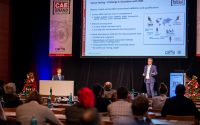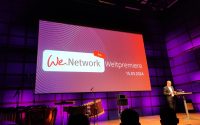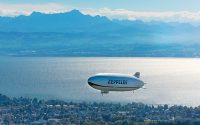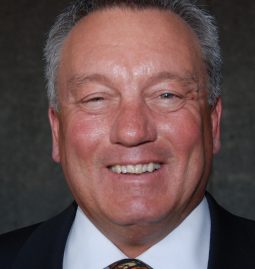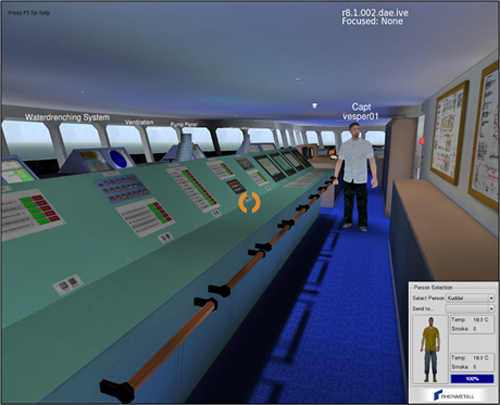 The maritime industry is an important industrial sector in Europe. It not only consists of the shipyards but of a broad variety of specific suppliers, classification societies, ship owners and crew members, operators of offshore facilities, and many more. The companies in this sector face strong international competition with cost pressure, increasing demands for security, safety, and ecology aspects.Compared to other industries, in this sector we find some unique requirements and conditions that are exceptionally challenging. To name just a few of these, we have to deal with limited-lot production, extremely complex products (more than one million parts), operation in quite harsh environments and high economic and ecological risks – e.g. in the case of cruise liners or oil platforms.The maritime sector offers a broad variety of applications for advanced computer graphics technology. Ranging from marketing and design through manufacturing support to familiarization, training and maintenance assistance, there is no phase in the lifecycle of a ship or seaborne structure that would not profit from 3D modelling, simulation, Virtual/Augmented Reality or computer vision.However, in order to exploit the potential of 3D technology in the maritime sector, the applications must be tailored to specific user demands, processes, and IT environments. This alignment is the focus of the German innovation network “3D maritim”. The institute for applied research in Visual Computing, Fraunhofer IGD, is managing the network. It bundles the expertise of specialized IT companies, research organizations, shipyards, maritime consultants, and ship owners. Within this unique combination, the network has three major objectives:
The maritime industry is an important industrial sector in Europe. It not only consists of the shipyards but of a broad variety of specific suppliers, classification societies, ship owners and crew members, operators of offshore facilities, and many more. The companies in this sector face strong international competition with cost pressure, increasing demands for security, safety, and ecology aspects.Compared to other industries, in this sector we find some unique requirements and conditions that are exceptionally challenging. To name just a few of these, we have to deal with limited-lot production, extremely complex products (more than one million parts), operation in quite harsh environments and high economic and ecological risks – e.g. in the case of cruise liners or oil platforms.The maritime sector offers a broad variety of applications for advanced computer graphics technology. Ranging from marketing and design through manufacturing support to familiarization, training and maintenance assistance, there is no phase in the lifecycle of a ship or seaborne structure that would not profit from 3D modelling, simulation, Virtual/Augmented Reality or computer vision.However, in order to exploit the potential of 3D technology in the maritime sector, the applications must be tailored to specific user demands, processes, and IT environments. This alignment is the focus of the German innovation network “3D maritim”. The institute for applied research in Visual Computing, Fraunhofer IGD, is managing the network. It bundles the expertise of specialized IT companies, research organizations, shipyards, maritime consultants, and ship owners. Within this unique combination, the network has three major objectives:
- To develop the market for 3D computer graphics in the maritime sector
- To serve as one single contact even for complex 3D process chains
- To shape the future with visionary ideas and applied research and developments projects.
The common vision of the network members is to establish a continuously evolving 3D model from design through production and training up to retrofit or recycling. It should not only cover the geometry but also the behaviour of the plant. It must be handled intuitively and should be pervasively available.In various working groups, 3D maritim covers a wide range of topics from lifecycle concepts for 3D data handling through interaction technology up to virtual training environments. All the applications areas share the same 3-step approach: In a first step we have to create a 3D model – either by modelling or by rebuilding. In a second step this raw model must be prepared for a given task and IT environment. In the last step the 3D model has to be prepared for visualization.We find the same high-level process in each phase of the ship’s lifecycle. It starts with a concept model that roughly describes the later product and has a strong focus on marketing issues. It is followed by a detailed CAD model that forms the basis for the manufacturing process. A third model is sometimes produced for the purposes of explaining the product and training. All those models are produced separately with specific tools and fulfil a specific task. Obviously, this lack of a single universal model is an example of redundant work that could be eliminated by technical and organizational improvements.Even if a high-performance 3D model is available, this is only one side of the coin. An interactive 3D environment also needs additional specifications including textures, animation paths, meta information (e.g. materials or weight) and a storybook that guides the user through a scenario. Up to now, there is no “silver bullet” available for doing this additional authoring in a standardized way. In a research project starting right now, 3D maritime partners are joining forces to increase efficiency in the authoring phase. All the available data from design (2D and 3D models, BOMs, etc.) and a generic and extendible product structure will be merged in a semi-automatic process. The resulting virtual ship not only offers visual representation as an environment for virtual training but also offers easily integrated semantic links, e.g. for interaction with simulators.Another recently launched research project is dedicated to the production phase. The aspired mobile measurement system will be used to monitor progress in assembly and outfitting. The resulting information is not only important for checking manufacturing plans against real progress but also to support novel tools such as Mixed Reality for the worker.To discuss innovative applications for 3D graphics, the marine community is meeting in Rostock/Germany on 30 August for the Go-3D 2012 conference. The presentations and the accompanying exhibition will provide a good overview of the state of the art and serve as a platform for sharing experiences and creating new ideas.
06/26/2012 | By Professor Uwe Freiherr von Lukas, Fraunhofer IGD, Rostock/Germany

